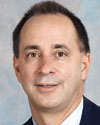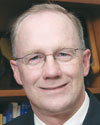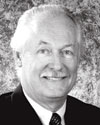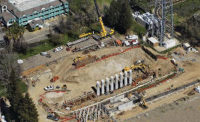
PETROCELLI
When asked how his company continues to excel while so many other design firms wither during the recession, Phil Petrocelli points to a project that AECOM Technology Corp. recently worked on in the Southern California desert.
A client wanted to build four solar power plants – capable of generating a combined 1,000 megawatts of electricity – near the city of Blythe in Riverside County. AECOM produced the environmental sustainability report for the $6-billion venture and guided the client through a mountain of government red tape to obtain all the required initial permits.
Moreover, AECOM did the job with relatively little controversy – almost unheard of for an energy project on such a large scale.
“This is the unique capability that AECOM brings,” Petrocelli, the firm’s western region chief executive says. “We have a soup-to-nuts ability to help get things done.”
Having the ability to offer clients a complete menu of services is a major reason why AECOM has consistently outperformed other design firms in terms of revenue, Petrocelli says. In fact, all of the executives California Construction interviewed for this article on the state’s top design firms for 2010 cited service diversity as a key factor in their success.
Los Angeles-based AECOM is No. 1 on the list, with more than $6.3 billion in worldwide revenue for the year thus far, $540 million of that in the Golden State alone. The firm was also No. 1 last year, with $464 million in California revenue.
Just 20 years old, AECOM (an acronym for Architecture, Engineering, Consulting, Operations and Management) has 47,000 employees in more than 100 countries around the world.
“We have a unique global footprint,” Petrocelli says. “It’s a situation where our size is a great benefit. We also try hard to maintain our focus on the key services we have to offer. Our main areas are in water/wastewater, transportation, energy, environmental design, planning design and development – anything that’s infrastructure.
“We’re also blessed with extremely talented people. We have a good organizational ability to reach into the industry and pull out the most talented employees.”
Size and diversity has also helped HDR Inc., an Omaha-based firm that weighed in at No. 3 on the list, says Bill Brinkman, the company’s director of operations for the western region. (Santa Ana-based CH2M Hill, which did not respond to requests for comment, was No. 2).

KELLY

BRINKMAN
HDR took in about $1.4 billion so far this year, including $191 million in California.
“We still have some international work going – that’s helped a lot,” Brinkman says. “We’re also doing work in Canada. HDR is big in work sharing: If we have too much work, say, in the East, they could push that work to the West.”
Greg Kelly, president of the Americas Transportation division of Parsons Brinckerhoff, cited diversity as “important” to his company’s record of success – and well he should. Headquartered in New York City, Parsons Brinckerhoff has 14,000 employees and 150 offices around the world. But even more important, Kelly says that even more important than size is the firm’s close relationships with its clients, most of whom are governments.
Parsons Brinckerhoff registered about $1.4 billion this year in worldwide revenue, $153 million in California.
“Our focus in California has been primarily in state and local governments and primarily in the transportation market sector,” Kelly says. “Probably the underlying reason for our success in California is our business model, which is built around those local clients. We have seven offices throughout California, and we try to maintain that local presence, which I think is a part of the reason we’ve maintained those client relationships over the years.”
Over the years, PB has translated those relationships into such high-profile contracts as the Central Subway extension and Presidio Parkway projects in San Francisco, and the Subway-to-the-Sea environment documentation and Westside Connector projects in L.A.

NIELSEN
Along with service diversity and what he described as “leading-edge thinking,” Stantec Inc.’s senior VP Eric Nielsen credits the vision of retired CEO Tony Franceschini for the Edmonton, Alberta-based company’s success. Stantec brought in more than $1.3 billion worldwide this year – just under $130 million of that in California.
“We’re not insulated from the recession – the industry is hurting,” Nielsen says. “But I think our performance success goes back to 1998, when our CEO put forward a 10-year plan become a Top 10 global design firm. He created and stuck with a series of tactical steps to achieve that.”
Franceschini’s plan was simple: create a global, single-brand identity by focusing on a core set of services.
“The idea was that we do professional services – we’re not contractors,” Nielsen adds.
In 1998, Stanley Associates, as the company was then called, had 2,000 employees in 40 offices; today, Stantec has more than 10,000 employees spread out in 150 offices across North America.
Nielsen says the company’s embrace of the sustainability has helped its competitive edge. He points to the zero-energy Research Support Facilities for the National Renewable Energy Laboratory outside Denver as one of his company’s more prominent sustainable achievements.
The $67-million, 222,000-sq-ft facility was certified LEED platinum. It was designed by Stantec in partnership with RNL Design of Denver and built by Haselden Construction of Centennial, Colo.









Post a comment to this article
Report Abusive Comment